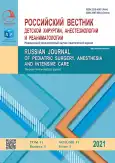Results of treatment of fifty children with persistent cloaca in one center
- Authors: Mokrushina O.G.1,2, Shumikhin V.S.1,2, Levitskaya M.V.2, Chundokova M.A.1,2, Halafov R.V.1,2, Shugina J.V.1,2, Petrova L.V.2, Koshko O.V.2, Emirbekova S.K.2
-
Affiliations:
- Pirogov Russian National Medical University
- Filatov Children’s Hospital
- Issue: Vol 11, No 3 (2021)
- Pages: 315-324
- Section: Original Study Articles
- URL: https://journals.rcsi.science/2219-4061/article/view/123567
- DOI: https://doi.org/10.17816/psaic985
- ID: 123567
Cite item
Full Text
Abstract
BACKGROUND: The preserved cloaca is a particular type of anorectal anomaly. The combination of urological, genital, and rectal abnormalities makes radical reconstruction difficult.
MATERIALS AND METHODS: This study examined operations performed in 50 patients with persistent cloaca treated from 2010 to 2021. Two groups are presented: the first with 35 children and a short canal (<3 cm), and the second with 15 children and a long canal (>3 cm). We examined the prognosis for bowel control, the type of operation, the need for vaginal reconstruction, complications after surgery, and the days of hospital stay.
RESULTS: Anomalies of the Müllerian ducts in the second group (94%) were higher than in the first (36%) (p < 0.001). The sacral index and myelodysplasia did not differ in both groups. The sacral index in the first group was 0.62 ± 0.14, and in the second group, it was 0.58 ± 0.14 (p = 0.520). Myelodysplasia in the first group was 33%, and in the second group, it was 38% (p = 0.744). Total urogenital mobilization (51%) was used in the first group, and abdominal reconstruction (54%) was used in the second group. Vaginal reconstruction was required in 28% of patients in the first group and 60% in the second group. Complications were 3.5 times more likely in the first group (60% versus 17% in the second) (p = 0.003). The length of hospital stay in patients in the second group was longer than that of patients in the first group.
CONCLUSION: Our study data demonstrate that the reconstruction of a persistent cloaca requires individual planning of the operation, considering the length of the canal and the state of all structures forming the cloaca.
Full Text
##article.viewOnOriginalSite##About the authors
Olga G. Mokrushina
Pirogov Russian National Medical University; Filatov Children’s Hospital
Author for correspondence.
Email: mokrushina@yandex.ru
ORCID iD: 0000-0003-4444-6103
SPIN-code: 5998-7470
Deputy Chief Physician for Surgery, professor of Department of Pediatric Surgery
Russian Federation, 15, Sadovaya-Kudrinskaya str., 103001, Moscow; MoscowVasiliy S. Shumikhin
Pirogov Russian National Medical University; Filatov Children’s Hospital
Email: pennylane@yandex.ru
ORCID iD: 0000-0001-9477-8785
SPIN-code: 6405-8928
head of newborn department, assistant professor
Russian Federation, 15, Sadovaya-Kudrinskaya str., 103001, Moscow; MoscowMarina V. Levitskaya
Filatov Children’s Hospital
Email: urolog@neosurg.ru
ORCID iD: 0000-0002-9838-9493
pediatric surgery
Russian Federation, 15, Sadovaya-Kudrinskaya str., 103001, MoscowMadina A. Chundokova
Pirogov Russian National Medical University; Filatov Children’s Hospital
Email: cmadina@yandex.ru
ORCID iD: 0000-0002-5080-4838
SPIN-code: 1122-0394
professor of Department of Pediatric Surgery, pediatric surgery
Russian Federation, 15, Sadovaya-Kudrinskaya str., 103001, Moscow; MoscowRashid V. Halafov
Pirogov Russian National Medical University; Filatov Children’s Hospital
Email: drrash777@gmail.com
ORCID iD: 0000-0001-7998-5639
pediatric surgery, assistent professor
Russian Federation, 15, Sadovaya-Kudrinskaya str., 103001, Moscow; MoscowJulia V. Shugina
Pirogov Russian National Medical University; Filatov Children’s Hospital
Email: doctorshugina@gmail.com
ORCID iD: 0000-0003-0982-8106
pediatric surgery, graduate student
Russian Federation, 15, Sadovaya-Kudrinskaya str., 103001, Moscow; MoscowLubov V. Petrova
Filatov Children’s Hospital
Email: celine1988@mail.ru
ORCID iD: 0000-0001-8727-5514
pediatric surgery
Russian Federation, 15, Sadovaya-Kudrinskaya str., 103001, MoscowOlga V. Koshko
Filatov Children’s Hospital
Email: kas321@gmail.com
ORCID iD: 0000-0002-6946-938X
anesthetist
Russian Federation, 15, Sadovaya-Kudrinskaya str., 103001, MoscowSvetlana K. Emirbekova
Filatov Children’s Hospital
Email: aisha.shabanova@yandex.ru
ORCID iD: 0000-0003-0334-3255
anesthetist
Russian Federation, 15, Sadovaya-Kudrinskaya str., 103001, MoscowReferences
- Levitt MA, Peña A. Cloacal malformations: lessons learned from 490 cases. J Pediatric Surg. 2010;19(2):128–138. doi: 10.1053/j.sempedsurg.2009.11.012
- Abdelhamid A, Bassiouny AZ. Persistent cloaca: persistence of the challenge. Annals of Pediatric Surgery. 2020;16:1–7. doi: 10.1186/s43159-019-0010
- Otamuradov FA, Ergashev NSh. Persisting cloaca in girls. The issues of diagnostics and surgical correction. Russian Journal of Pediatric Surgery, Anesthesia and Intensive Care. 2016;6(4):108–111. (In Russ.)
- Kirgizov IV, Minaev SV, Gladkij AP, et al. Multicenter research of persistent cloacal malformation surgery in children. Medical news of North Caucasus. 2014;9(4):295–299. (In Russ.) doi: 10.14300/mnnc.2014.09083
- Versteegh HP, Sutcliffe JR, Sloots CE, et al. Postoperative complications after reconstructive surgery for cloacal malformations: a systematic review. Tech Coloproctol. 2015;19(4):201–207. doi: 10.1007/s10151-015-1265-x
- Mokrushina OG, Shchapov NF, Menovshchikova LB, et al. Radikal’naya korrektsiya persistiruyushchei kloaki metodom total’noi urogenital’noi mobilizatsii u devochki 3-kh mesyatsev. Russian Journal of Pediatric Surgery, Anesthesia and Intensive Care. 2013;3(4):108–111. (In Russ.)
- Singh Bal H, Sen S, Sam C, et al. Urogenital management in cloaca: An alternative approach. J Indian Assoc Pediatr Surg. 2017;22(2):108–113. doi: 10.4103/0971-9261.202683
- Liem NT, Quynh TA. Laparoscopic rectal pull-through for persistent cloaca: an easier approach for a complex anomaly. J Pediatr Surg. 2012;47(4):815–818. doi: 10.1016/j.jpedsurg.2012.02.004
- Hendren WH. Cloacal malformations: experience with 105 cases. J Pediatr Surg. 1992;27(7):890–901. doi: 10.1016/0022-3468(92)90393-L
- Versteegh HP, Sloots CEJ, de Jong JR, et al. Early versus late reconstruction of cloacal malformations: The effects on postoperative complications and long-term colorectal. J Pediatr Surg. 2014;49(4):556–559. doi: 10.1016/j.jpedsurg.2013.10.028
- Cho M-J, Kim T-H, Kim D-Y, et al. Clinical experience with persistent cloaca. J Korean Surg Soc. 2011;80(6):431–436. doi: 10.4174/jkss.2011.80.6.431
- Adamyan LV, Darenkov SP, Shelygin YuA, et al. A clinical case of congenital cloacal anomaly of pelvic organs. Obstetrics and Gynecology. 2012;(8-1):60–63. (In Russ.)
- Halleran DR, Thompson B, Fuchs M, et al. Urethral length in female infants and its relevance in the repair of cloaca. J Pediatric Surgery. 2019;54(2):303–306. doi: 10.1016/j.jpedsurg.2018.10.094
Supplementary files









